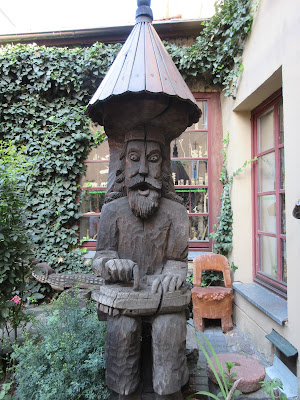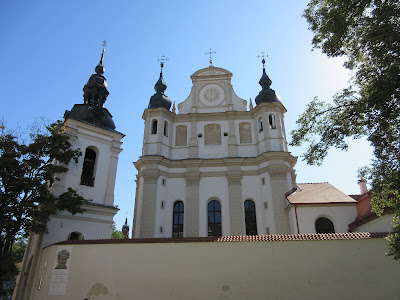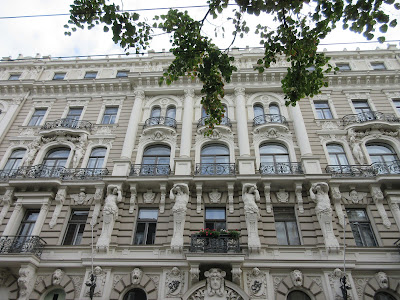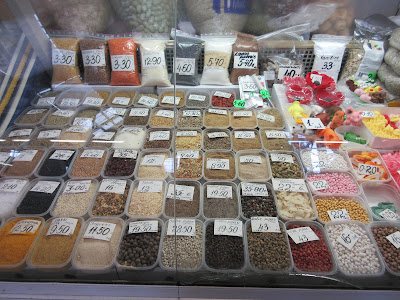We love having you along with us as we explore the culture, architecture, history, and of course, the food of these countries. If you're new to our blog, know that you'll get all the advantages of travel plus some attitude--with none of the jetlag, packing, immunizations, Montezuma's revenge, or expense. So, welcome aboard!
Tuesday and Wendsday, August 7-8, 2018
Laba diena (Hello) from Vilnius, Lithuania!!! This is the capital and largest city (540,000) in the country.
As usual, we arrived a day earlier than the start of the tour. This is to account for possible travel delays plus give us time to ward off jet lag, and to give us the opportunity for a pre-tour tour (more in a moment).
We got into Vilnius around 1:00 and were out of the airport in 10 minutes (having gone through a cursory customs check in Frankfurt). Our Tauck driver made a point of mentioning how clean the highway was, showing obvious Lithuanian pride.
After a quick stop in the room, we headed out to explore (and keep Morpheus at bay for a few hours). It was in the upper 70s, and except for a brief but intense shower, the weather was perfect.
Our hotel, the Kempinski, is right in the center of the Old Town. And this really IS the Old Town, containing many buildings that are centuries old. Many, many churches (so many saints!), and the University of Vilnius, which was founded in 1579! Here are some buildings from one of its 13 courtyards.
At the edge of the Old Town is Cathedral Square, dominated by the Vilnius Cathedral (full name: Cathedral Basilica of St Stanislaus and St Ladislaus of Vilnius - two saints!) ,which will be visited by Pope Francis next month.
(internet photo, since the front is currently covered by scaffolding for
repair and renovation prior to the Pope's visit)
The Cathedral's clock / bell tower
Then...time to sample our first taste of Lithuanian food. There are many restaurants along Pilies, the main street in this part of town. It appears that tourism is big here! We found one that was busy (took that as a good sign) and ordered from an amazing menu that had photos of each dish and Lithuanian and English descriptions. What was also very interesting is that the dishes were divided into three sections: The Ancient Kingdom - featuring dishes from the 19th and early 20th centuries; The Inter-War - dishes from 1918 - 1940 which introduced more international flavors; and The Slumber Land - dishes from the last half of the 20th century - "...the saddest period of Lithuanian history..".
We chose to share Vistiena su keptu kopustu (chicken with roasted cabbage and potatoes and cowberry sauce) and Apkeptas didzkukulis (fried potato dumpling - sort of a pear-sized tater tot stuffed with mystery meat). Both were delicious!!!
Then back to our hotel. Passed this street sign along the way. Never saw one like this before!!
(Wednesday) We had arranged for a Jewish day tour with Milk and Honey Tours. Our guide was Svetlana. Yes, blond and Lithuanian. Yes, Jewish. She told us that during the 50 years of Soviet occupation of the country, many children were given Russian names!
She first took us across the street to the Cathedral. As we walked in the plaza, she pointed out a meter wide strip of red bricks that zig-zagged across; this represents the part of the wall that surrounded the original town. Outside this wall is the new part of town - from the 1700s!
Near the Cathedral is a statue of Grand Duke Gediminas, who built the town as a result of a dream. At that time, Lithuania was much larger, and included parts of present day Poland, Belarus, and Ukraine. In fact, Bialystok (where Wayne's family is from) was also included in that domain!
In Gediminas's time, the social order of the country was Lords and Serfs. He thought a middle class was needed, so he issued a proclamation and sent it to other kings in Europe inviting Jews to come and live in Lithuania tax free! Over the next century many did come and settled there; thus the beginning of the Litwaks. The Litwaks were considered to be quite learned and observant.
At one point, 40% of the people in Vilnius spoke Yiddish (pronounced "Iddish" in Lithuanian/English by Svetlana). Here is a street sign with the name in Lithuanian, Yiddish, and Hebrew.
For those who may not know, Yiddish is a language that originated in Europe, is based on German, but uses the Hebrew alphabet! In fact, Svetlana explained that the Yiddish spoken and taught in Vilnius is the "true Yiddish."
Every so often, Svetlana would pull out a photograph from 75 - 100 years ago that showed the view from the same spot we were standing! Most of the buildings were still standing, though now the original stoned walls have been plastered over. This area suffered little damage in WWII, as the people initially welcomed the Germans as liberators over the Communists.
In the 1700s, there was a brilliant Jewish scholar who lived in this part of town: Elijah ben Solomon Zalman. He is better known as the Vilna (which is how the town is pronounced here) Gaon (which means "genius" in Yiddish).
He lived a simple life that was dedicated to learning. But, unlike the rabbis who focused exclusively on Torah and Talmud, he also included the sciences and history; a more well-rounded education. Others began to follow his model and came to Vilnius to study, thus making it a center of European intellectualism for decades.
This statue of the Gaon was erected about 25 years ago. Ironically, the remaining Jewish citizens are not happy with it; the sculptor who made it did not put a kippah on his head!
Near to this statue is a Soviet era building used as a school. But it sits on the grounds of what was the Great Synagogue in the Gaon's time (actually built in the 1630s - the first in the country to be made of stone - and destroyed in 1957 by the Soviets). The interesting story of that building is this: When it was being designed, there were two rules that had to be followed. First, traditional law said no building could be higher than the town's church. But the Talmud says that a synagogue should be the most prominent building in the town. How to reconcile these two opposing rules? The building was built as high as could be allowed. But......the foundation was built two stories deep below ground. So the actual inside was huge and lofty (up to 3,000 men could be seated for worship)! Problem solved. Archaeologists began digging here in 2016 (the bimah was actually "discovered" 3 weeks ago!) and plans are for a partial restoration and memorial.
A few blocks away is the current Vilna Choral Synagogue, which was built in 1903. Quite ornate! Choral synagogues stand out from the other more traditional
synagogues in the shtetls, and were started in central and eastern Europe
during the Jewish enlightenment. This was the first choral
synagogue we have visited, even though we spent 2 weeks in Central
Europe in 2012.
And upstairs, in the women's gallery, is something we've never seen before: a 20 foot long matzo making machine!
Of course, there is a controversy attached to such a machine; you can read about it here.
And, as we have seen in many other places, this once vibrant and fully integrated community of Jews was almost completely wiped out in WWII. There are only 3,000 left in the country.
Thus, our final stop of the day was Paneriai Forest, the site where 70,000 Jews (and many Red Army soldiers) were murdered from 1941 - 1944. This was the most stunning and
memorable part of the day.
Unlike Jews in other parts of Central and
Eastern Europe, the Jews from Vilnius and other large cities in Russia
were not killed in concentration camps. Most of them ended up here. Prior to the war, the Russians had begun work to turn this forest into an airport (and it was right alongside the railroad tracks). In doing so, they dug 7 huge pits which would be used to store fuel. When the Nazis took over the country, they realized that this area would be ideal for the mass slaughter they had planned.
Taken in trains or buses, the Jews were told they were going to the forest-- which, for some
had been a summer vacation spot in better days. Many believed this was a way station on the journey to be relocated somewhere. However, once there, they were told to place all their suitcases and belongings in one pit, then they were led to another and summarily executed (shot).
The forest is rarely visited and today was no exception. Only one other person was there besides us. It was eerie and almost serene; we stopped at several chilling memorials.
Svetlana
told us the inspiring story of a Polish journalist who had moved to the
neighboring town when he had to leave the journalism field to start a
carpenter business. Apparently, he caught wind of what was going on in
the forest, and could actually see the executions from his rooftop. He documented it fully but his reports were never sent out. He was killed near the end of the war, and the Russians took his notes. They were not made public until perestroika in the late '80s.
It is unfortunately sad and numbing that in our travels we have visited several of Hitler's extermination sites. They are all awful. The juxtaposition of this one's natural beauty with the knowledge of what actually transpired here was horrifying beyond words.
Tonight the tour officially starts with the Welcome Dinner. And tomorrow we will explore Vilnius (again) and then visit a castle in the country.
Until then,
love, w&w…………..





































































































